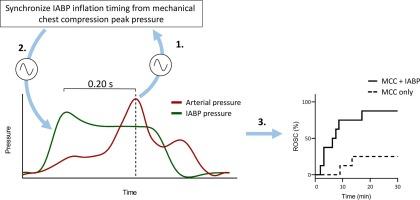Intra-aortic balloon pump synchronized with chest compressions improves outcome during cardiopulmonary resuscitation in experimental cardiac arrest
IF 6.5
1区 医学
Q1 CRITICAL CARE MEDICINE
引用次数: 0
Abstract
Background
Intra-aortic balloon pump (IABP) and resuscitative endovascular balloon occlusion of the aorta (REBOA) are two endovascular intervention methods for circulatory support. The aim of this study was to compare the hemodynamic effects of simultaneous mechanical chest compressions (MCC) with IABP, REBOA and those with only MCC (overall and detailed in the MCC cycle) and return of spontaneous circulation (ROSC) during cardiopulmonary resuscitation (CPR) in experimental non-traumatic cardiac arrests (CA).
Method
CA was electrically induced (ventricular fibrillation) in 24 anesthetized pigs, which then were randomized to MCC synchronized IABP (n = 8), total occluded REBOA (n = 8), or control (n = 8). After 10 min of CA, CPR with MCC was started followed by one of the interventions after one minute of CPR. Every other minute after MCC start, the pigs were defibrillated with 200 J if VF/ventricular tachycardia, and after six minutes, adrenaline was administered and repeated every four minutes. The proportions of ROSC were calculated. Hemodynamic variables, including systemic blood and coronary perfusion pressures (CPP), and carotid and iliac blood flows, were collected and analyzed with 0.02 s resolution.
Results
In both the IABP and REBOA groups, 7 of 8 animals (87.5 %) achieved ROSC, in contrast with 2 of 8 (25 %) in the control group (P = 0.04). IABP and REBOA significantly increased systemic arterial pressure (P = 0.002 and P = 0.015, respectively), and REBOA also increased CPP and carotid blood flow when compared to controls (P = 0.007 and P = 0.03, respectively). Animals with IABP had a preserved blood flow in the iliac artery during CPR. No differences were detected after ROSC in hemodynamic, metabolic, and organ injury variables between the REBOA and IABP groups.
Conclusion
Both IABP and REBOA increased the proportion of ROSC compared to controls. However, REBOA occluded distal blood flow, while IABP maintained it. This study suggests that MCC synchronized IABP could be an adjunct in the treatment of non-traumatic CA.

主动脉内球囊泵与胸外按压同步进行可改善实验性心脏骤停患者的心肺复苏效果。
背景:主动脉内球囊泵(IABP)和主动脉血管内球囊闭塞复苏术(REBOA)是两种用于循环支持的血管内介入方法。本研究旨在比较在实验性非创伤性心脏骤停(CA)的心肺复苏(CPR)过程中,同时进行机械胸外按压(MCC)与 IABP、REBOA 和仅进行机械胸外按压(MCC)的血流动力学效果(整体效果和 MCC 循环中的细节效果)以及自发性循环(ROSC)的恢复情况:方法:对 24 头麻醉猪进行电诱导 CA(心室颤动),然后将其随机分配到 MCC 同步 IABP(n = 8)、全闭塞 REBOA(n = 8)或对照组(n = 8)。CA 10 分钟后,开始用 MCC 进行心肺复苏,然后在心肺复苏一分钟后进行其中一种干预。MCC 启动后每隔一分钟,如果出现 VF/室性心动过速,则对猪进行 200 J 除颤,6 分钟后注射肾上腺素,每 4 分钟重复一次。计算 ROSC 的比例。收集并分析了血液动力学变量,包括全身血压和冠状动脉灌注压(CPP)以及颈动脉和髂动脉血流,分辨率为 0.02 秒:在 IABP 组和 REBOA 组中,8 只动物中有 7 只(87.5%)实现了 ROSC,而在对照组中,8 只动物中有 2 只(25%)实现了 ROSC(P = 0.04)。与对照组相比,IABP 和 REBOA 能明显增加全身动脉压(分别为 P = 0.002 和 P = 0.015),REBOA 还能增加 CPP 和颈动脉血流量(分别为 P = 0.007 和 P = 0.03)。使用 IABP 的动物在心肺复苏期间髂动脉血流保持不变。ROSC后,REBOA组和IABP组在血液动力学、代谢和器官损伤变量方面未发现差异:结论:与对照组相比,IABP和REBOA都提高了ROSC的比例。结论:与对照组相比,REBOA 和 IABP 都提高了 ROSC 的比例,但 REBOA 闭塞了远端血流,而 IABP 维持了远端血流。这项研究表明,MCC同步IABP可作为治疗非创伤性CA的辅助手段。
本文章由计算机程序翻译,如有差异,请以英文原文为准。
求助全文
约1分钟内获得全文
求助全文
来源期刊

Resuscitation
医学-急救医学
CiteScore
12.00
自引率
18.50%
发文量
556
审稿时长
21 days
期刊介绍:
Resuscitation is a monthly international and interdisciplinary medical journal. The papers published deal with the aetiology, pathophysiology and prevention of cardiac arrest, resuscitation training, clinical resuscitation, and experimental resuscitation research, although papers relating to animal studies will be published only if they are of exceptional interest and related directly to clinical cardiopulmonary resuscitation. Papers relating to trauma are published occasionally but the majority of these concern traumatic cardiac arrest.
 求助内容:
求助内容: 应助结果提醒方式:
应助结果提醒方式:


